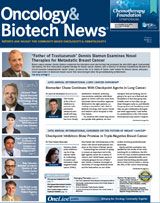Publication
Article
Oncology & Biotech News
DNA Damage Response: A Constant Effort to Maintain Cell Integrity Might Help Cancer Patients After All
The continued progress in understanding and deciphering the critical role of the DNA damage response might help us stratify cancer patients in the future and personalize their therapies.
Andre Goy, MD
Editor-in-Chief of Oncology & Biotech News
Chairman and Director Chief of Lymphoma Director, Clinical and Translational Cancer Research John Theurer Cancer Center at Hackensack University Medical Center
The preservation of DNA integrity—also called genetic stability—is essential to our survival. This involves accurate DNA replication with each cell division and the ability to repair any occurring error. Such errors occur for a myriad of reasons including heat, oxidative stress, UV exposure, chemicals, or radiation exposure, among others. It is estimated that up to one million individual lesions occur per cell every day, but only one out of a thousand accidental base change results in a permanent mutation.
Evidently, in the absence of repair, these mutations will either lead to early cells senescence (aging), apoptosis (cell death: thus preventing mutated cells from replicating), or potentially abnormal cells accumulation and/or aberrant cell division (leading to transformation into cancer cells).
The critical role of the DNA repair complex system is illustrated by rare but well-established syndromes arising from mutations in DNA damage—response genes—such as ataxia telangiectasia, Bloom syndrome, Fanconi’s anemia, Lifraumeni syndrome (p53 defect), and xeroderma pigmentosum, among others. Such syndromes are characterized by either accelerated aging disease or malformations/degenerative diseases and particularly, by a very high incidence of cancers across all these patients.
The DNA damage response is a network of cellular pathways that sense, signal and repair DNA lesions. Surveillance proteins that monitor DNA integrity can activate cell cycle checkpoints and DNA repair pathways in response to DNA damage, to prevent the generation of potentially deleterious mutations. In simpler words, the DNA repair system functions like a “gatekeeper,” telling a cell to “stop and repair” or “die if it’s too late.”
The discovery of the DNA repair system dates back to the late 1980s, with work showing its critical role in both prokaryotes and eukaryotes. The growing importance of this seminal work over the years, led to the recent 2015 Albert Lasker Basic Medical Research Award to Evelyn M. Witkin, 94, of Rutgers University, and Stephen J. Elledge, 59, of Brigham and Women’s Hospital in Boston.
Witkin’s work started in the 1940s, showing that some bacteria (E Coli) were able to recover from UVinduced DNA damages and that their resistance to UV radiation was heritable and also protected them from x-rays. Elledge’s work in yeast later on established that the DNA damage response in eukaryotes is a signal transduction pathway involving a kinases cascade, with some mammalian homologues of yeast kinases that can prevent cell-cycle progression in response to DNA damage (checkpoints). The DNA can be repaired fairly easily and reliably because it carries two separate copies of all the genetic information in each cell.
Mammalian cells have evolved highly conserved DNA repair mechanisms with at least eight distinct DNA repair pathways resulting either in simple direct repair after proofreading, excision-repair, cross-link repair, mismatch repair, or recombination. The DNA damage response (DDR) overall however is a highly complex signaling system involving tightly controlled involving regulation at the transcriptional, posttranscriptional, and posttranslational levels.
The predisposition to cancer conferred by mutations in DNA-repair genes is well documented. Among the most common examples are breast and ovarian cancer from mutations in homologous recombination genes (BRCA1/2) and colon cancer from mutations in mismatch-repair genes, with a number of subentities reported. Impaired DNA repair is a major driver for carcinogenesis (through driver mutations, deletion of tumor suppressors, and/ or chromosomal rearrangements) and could promote aggressive cancer biology.
Emerging clinical data provide compelling evidence that overexpression of DNA repair factors may have prognostic and predictive significance in patients. Interestingly, in established tumors, DNA repair activity is required to counteract oxidative DNA damage that is often prevalent in the tumor microenvironment. Meanwhile, DNA-damaging agents like most chemotherapy currently used, can potentially induce further damages leading to resistance of cancer cells. On the other hand, recently, DNA repair inhibition has emerged as a promising target for anticancer therapy with a strong rational, for example, for synergistic efficacy of PARP1 inhibitors with chemotherapy in BRCA1/2-mutated cells.
The maintenance of DNA integrity is a very complex and highly regulated, very efficient process (3B bp to check at every division!). This system is by definition constantly challenged from both internal and external factors. The continued progress in understanding and deciphering the critical role of the DNA damage response might help us stratify cancer patients in the future and personalize their therapies. It is a perfect segue to our John Theurer Cancer Center annual survivorship event this past weekend that brings together thousands of patients every year for a Celebration of Life and Liberty!










